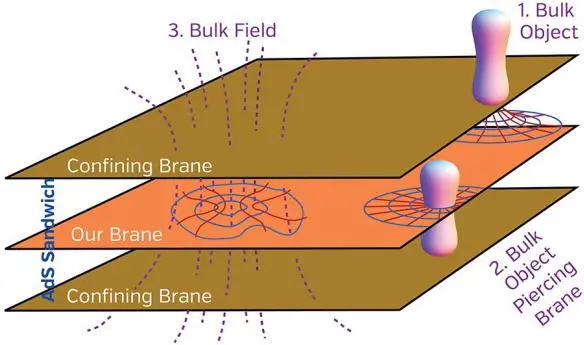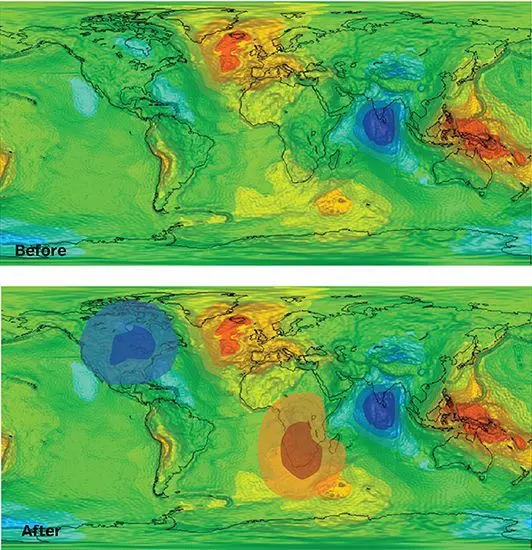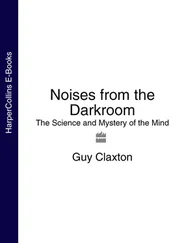In the movie, grown-up Murph (played by Jessica Chastain) discusses the math in her notebook with the Professor (played by Michael Caine). Murchikova, an expert in quantum gravity and cosmology, was on set to advise Chastain about her dialog and notebook, and things she was to write on the blackboard. It was startling to see these two brilliant and beautiful women from very different worlds, both with bright red hair, huddled together.
As for me, I filled Professor Brand’s blackboard with diagrams and mathematics (Figure 25.8, below), including the Professor’s equation—THE equation—at Christopher Nolan’s request, of course. And I took great pleasure in talking with Michael Caine (Figure 25.1), who seemed to view me as a sort of prototype for the Professor he was playing. And great pleasure in watching Chris, a master craftsman, mold the scenes he was filming into precisely the form he wanted.

Fig. 25.1. Michael Caine (the Professor) and I, on set in the Professor’s office.
Some weeks before filming in the Professor’s office, Chris and I went back and forth about what should be the nature of THE equation. (In Figure 1.2, back in Chapter 1, Chris is holding a sheaf of papers about the equation, which we are discussing.) Here’s my long scientist’s interpretation for what we wound up with—my extrapolation of the movie’s story.
Source of the Anomalies—The Fifth Dimension
In my extrapolation, it does not take long for the Professor to convince himself that the anomalies are due to gravity from the fifth dimension. From the bulk. Why?
The sudden changes in tidal gravity have no apparent source in our four-dimensional universe. For example, in my extrapolation the Professor’s team sees the tidal gravity above an oil deposit switch, in just a few minutes, from the pattern we expect (top picture in Figure 25.2) to a radically different pattern (bottom picture). The oil has not moved. The rocks have not shifted. Nothing in our four-dimensional universe has changed except the tidal gravity.

Fig. 25.2. Tendex lines (Chapter 4) describing the tidal gravity above an oil deposit before and after a sudden change.
These sudden changes must have a source. If the source is not in our universe, on our brane, then there is only one other place it can be, the Professor reasons: in the bulk.
In my extrapolation, the Professor can think of just three ways that something in the bulk could produce these anomalies, and the first two he quickly rejects:
1. Some object in the bulk—perhaps even a living object, a bulk being—might come near our brane but not pass through it (upper right of Figure 25.3). The object’s gravity reaches out through all the bulk’s dimensions and so could reach into our brane. However, the AdS layer surrounding our brane (Chapter 23) would drive the object’s tidal tendex lines parallel to our brane, allowing only a minuscule portion to reach our brane. So the Professor rejects this.
2. A bulk object, passing through our brane, could produce tidal gravity that changes as the bulk object moves (middle right of Figure 25.3). However, in my extrapolation most of the patterns of changing gravity that the Professor’s team observed don’t fit this explanation. The tendex lines tend to be more diffuse than those from a localized object. Some tidal anomalies might be from localized objects, but most must be something else.
3. Bulk fields passing through our brane could produce the changing tidal gravity (left side of Figure 25.3). This, the Professor concludes in my extrapolation, is the most likely explanation for most of the anomalies.
What is a “bulk field”? Physicists use the word field to mean something that extends out through space and exerts forces on things it encounters. We have already met several examples of fields that live in our universe, our brane: In Chapter 2, magnetic fields (collections of magnetic force lines), electric fields (collections of electric force lines), gravitational fields (collections of gravitational force lines); and in Chapter 4, tidal fields (collections of stretching and squeezing tendex lines).

Fig. 25.3. Three ways that the bulk could produce the observed gravitational anomalies. The red and blue curves are tidal tendex lines produced by a bulk object or bulk field.
A bulk field is a collection of force lines that resides in the five-dimensional bulk. What kind of force lines, the Professor doesn’t know, but he speculates; see below. Figure 25.3 shows a bulk field (dashed purple lines) passing through our brane. This bulk field generates tidal gravity in our brane (red and blue tendex lines). As the bulk field changes, its tidal gravity changes, resulting (the Professor thinks) in most of the observed anomalies.
But that isn’t the only role of bulk fields, he suspects—in my extrapolation. They may also control the strength of the gravity produced by objects living in our brane, such as a rock or planet.
Bulk Fields Control the Strength of Gravity
The gravity of each little bit of matter in our brane is governed, to high accuracy, by Newton’s inverse square law (Chapters 2 and 23): its gravitational pull is embodied in the formula g = Gm / r 2, where r is distance from that bit of matter, m is the mass of that bit of matter, and G is Newton’s gravitational constant. This G controls the overall strength of the gravitational pull.
In Einstein’s more accurate, relativistic version of the gravitational laws, the strength of gravity, and the strength of all the warping of space and time produced by matter, are also proportional to this G .
If there is no bulk—if the only thing that exists is our four-dimensional universe—then Einstein’s relativistic laws say that G is absolutely constant. The same everywhere in space. Never changing in time.
But if the bulk does exist, then the relativistic laws allow this G to change. It might , the Professor speculates, be controlled by bulk fields. It probably is controlled by bulk fields, he thinks. That’s the best explanation for one of the observed anomalies (Figure 25.4) in my extrapolation of the movie’s story.
The strength of the Earth’s gravitational pull varies slightly from place to place due to the varying density of the rocks, oil, oceans, and atmosphere. Earth-orbiting satellites have mapped this varying strength. As of 2014 the most accurate map is from the European Space Agency’s satellite GOCE [41] Gravity field and steady-state Ocean Circulation Explorer, GOCE.
(top half of Figure 25.4). In 2014, the Earth’s gravity is weakest in southern India (blue spot) and strongest in Iceland and Indonesia (red spots).

Fig. 25.4. Maps of the Earth’s gravitational pull. Top : In 2014 as measured by the GOCE satellite. Bottom : After the sudden change in the era of anomalies.
In my extrapolation, this map did not change noticeably until anomalies started appearing. Then one day, quite suddenly, the Earth’s gravitational pull in North America weakened a bit, and in South Africa it strengthened (bottom half of Figure 25.4).
Читать дальше
















